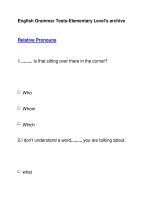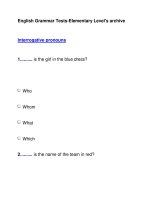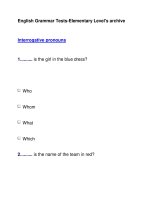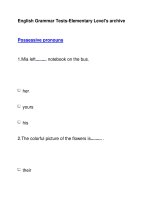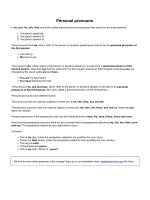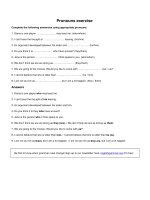ENGLISH PRONOUNS
Bạn đang xem bản rút gọn của tài liệu. Xem và tải ngay bản đầy đủ của tài liệu tại đây (13.41 MB, 28 trang )
Can Chính Truong's Archives
L
GUAGE
N
A RTS
A
EXPLORER
JUNIOR
Pronouns
these
his
he
her
those
by Katie Marsico
Cherry Lake Publishing • ann arbor, michigan
text:
A note on the
Certain words
d
are highlighte
f
as examples o
Bold, c
pronouns.
olorful
words a
re
vocabu
lary wo
Published in the United States of America by Cherry Lake Publishing
rds
Ann Arbor, Michigan
a
n
d can b
www.cherrylakepublishing.com
e found
in the g
Content Adviser: Lori Helman, PhD, Associate Professor, Department of
lossary
Curriculum & Instruction, University of Minnesota, Minneapolis, Minnesota
.
Photo Credits: Page 4, ©Levranii/Dreamstime.com; page 8, ©Monkey
Business Images/Shutterstock, Inc.; page 11, ©Brenda Carson/Shutterstock,
Inc.; page 16, ©MANDY GODBEHEAR/Shutterstock, Inc.; page 19,
©Sonya Etchison/Dreamstime.com; page 20, ©PhotoAlto/Alamy.
Copyright ©2014 by Cherry Lake Publishing
All rights reserved. No part of this book may be reproduced or utilized in
any form or by any means without written permission from the publisher.
Library of Congress Cataloging-in-Publication Data
Marsico, Katie, 1980–
Pronouns / By Katie Marsico.
pages cm. — (Language Arts Explorer Junior)
Includes bibliographical references and index.
ISBN 978-1-62431-178-9 (lib. bdg.) — ISBN 978-1-62431-244-1
(e-book) — ISBN 978-1-62431-310-3 (pbk.)
1. English language—Pronoun—Juvenile literature. I. Title.
PE1261. M37 2013
428.2—dc23
2013006092
Cherry Lake Publishing would like to acknowledge the work of The
Partnership for 21st Century Skills. Please visit www.p21.org for more
information.
Printed in the United States of America
Corporate Graphics Inc.
July 2013
CLFA13
2
Table of Contents
c ha p t er o ne
Are They Here Yet? . . . . . . . . . . . . . . . 4
cha pt er t wo
A Look at Pronouns . . . . . . . . . . . . . . 8
cha pt er t h r e e
Recognize the Rules! . . . . . . . . . . . . 16
Glossary . . . . . . . . . . . . . . . . . . . . . . 22
For More Information . . . . . . . . . . . 23
Index . . . . . . . . . . . . . . . . . . . . . . . . 24
About the Author . . . . . . . . . . . . . . 24
3
c ha p t er o n e
Are They Here Yet?
Have you ever rolled out
dough to make cookies?
Sam was thrilled that his cousins were coming
to visit. He helped his mom bake cookies while
he waited for them to arrive.
“Gosh, are they here yet?” Sam wondered
aloud. He looked out the window. “I feel like I
have not spent time with them in forever!”
“That is true,” said his mom. “Their
schedules have been crazy. You have not
seen each other in a while.”
4
“What should we do when they arrive,
Mom?” Sam asked.
“Whatever you and your cousins want,”
she answered. “I think you should decide for
yourselves. For starters, I hope you eat these
delicious cookies. Would you like to try some
now?”
Sam and his mom used pronouns to discuss
his cousins’ visit. Pronouns are words that
substitute, or take the place of, a noun or noun
phrase. Nouns and noun phrases identify a
person, place, object, quality, or action.
S IDE
T
C
E
AS
OBJ
P L AC E S
S
L
A
M
E
L
P
I
O
E
P
AN
5
The noun or noun phrase that a pronoun
replaces is called the antecedent. The
antecedent usually comes at some point
before the pronoun in a text or conversation.
Otherwise, it would not be clear what exactly
a pronoun identified!
“Jim is my favorite cousin,” said Sam. “He
loves soccer just like me!” Here the pronoun
he refers to the antecedent Jim.
Imagine if Sam never mentioned anyone’s
name: “He is my favorite cousin,” said Sam.
“He loves soccer just like me!” Without an
antecedent, it is not clear to whom the
pronoun he refers.
Who is he
?
6
nk about it
Thi
Extra Examples
Sam took a cookie. It was still hot.
Pronoun: it
Antecedent: cookie
Sam ate the cookie. Then he was full.
Pronoun: he
Antecedent: Sam
Sam’s mom untied her apron.
Pronoun: her
Antecedent: Sam’s mom
7
c ha p t er T wo
A Look at Pronouns
People often use pronouns to tal
k about other
people, such as their friends an
d family.
“They are at the door!” yelled Sam. “Mom, I
see them!”
“Go ahead and let your cousins in, Sam,” his
mom answered. “Please take their coats, too.”
“Sam, how great to see you,” his cousin
Anna said. She gave Sam a big hug. Jim
followed her inside.
“Hey, Sam,” he shouted. “Do you have a
hug for your other cousin?”
8
those
that this
e
s
e
th
its
s
r
he h mine
me im
I w
e us you his
he
they
e
h her th
s
eirs
ours it
rs
u
o
y
Many pronouns
refer to a person,
an object, or a group
of people or objects. I, me, we, us, you, he,
she, him, her, it, they, and them are personal
pronouns. So are the words mine, ours, yours,
his, hers, its, and theirs.
“This is going to be an awesome visit,” said
Anna. “What smells so good?”
“Those are cookies Mom and I made,”
replied Sam. Some pronouns point out the
antecedent. This and those are two examples.
For example, in Sam’s sentence, those is the
pronoun. Cookies is the antecedent. That and
these are also used in this way.
9
JUNI
O
visit
ctivity,
a
is
h
t
ities.
f
m/activ
a copy o
o
t
.c
e
g
g
in
o
h
T
epublis
errylak
h
.c
w
w
w
STOP!
DON
’’T
T WRITE
IIN
N THE BOOK!
ACTIVITY
Locate and List!
Locate and list all the pronouns in the following
sentences:
“We ate lunch but are still starving,” said Jim.
“That was hours ago,” added Anna. “Besides, I
always have room for Aunt Sara’s desserts!”
“Those look delicious,” Jim agreed. He stared
at the cookies.
Answers: we, that, I, those, he
“The batch that we baked today is
chocolate chip,” said Sam’s mom.
“I do not know anyone who turned down
Aunt Sara’s cookies,” said Jim. Sometimes a
pronoun begins a clause, or phrase, that
gives more information about its antecedent.
For example, the pronoun that refers to the
10
noun batch. The pronoun leads a clause
explaining what kind of cookie the batch is.
“I will help myself to a little snack,” said
Anna. Some pronouns refer back to a
sentence’s subject. The subject of a sentence is
what performs the action in a sentence. Here,
the subject is I and the action is will help. The
pronoun myself refers back to the subject, I.
Such pronouns are called reflexive. They show
a subject is doing something to itself.
Pronouns are use
d to begin clause
s
that give extra
details about
something, inclu
ding delicious co
okies!
11
your
f
l
e
self
s
y
m ourselves
h
f
erself
l
e
s
it
himself
s
e
v
l
e
s
m
the
Reflexive
pronouns end
in -self or -selves.
They include myself,
ourselves, yourself, yourselves, himself, herself,
itself, and themselves. Removing reflexive
pronouns changes a sentence’s meaning or
causes the sentence to no longer make sense. “I’ll
just help myself to some of those cookies” would
become “I’ll just help to some of those cookies.”
“I myself love baking sugar cookies,”
announced Jim. Here, the pronoun myself is
intensive. Intensive pronouns look like reflexive
pronouns but have a different job. They add
special importance to their antecedents. They
are not necessary to the text. For example, try
12
, visit
activity
s.
is
h
t
f
o
py
activitie
o
/
c
m
a
o
t
.c
e
g
To g
blishin
ylakepu
r
r
e
h
.c
www
EXPLNIOR
JU
STOP!
DON’’T
T WRITE
IIN
N THE BOOK!
ACTIVITY
Read and Rethink!
Read the following conversation. Pay attention to
the pronouns in red. Label each one as reflexive or
intensive. (Remember, you can remove an intensive
pronoun without changing a sentence’s meaning!):
“You yourselves would be able to make this recipe,”
said Sam’s mom.
“We are not allowed to cook by ourselves,”
replied Anna.
“I do not bake by myself either,” said Sam.
“But these directions are simple enough for kids
themselves to follow.”
Answers: yourselves, intensive; ourselves,
reflexive; myself, reflexive; themselves, intensive
removing the pronoun myself from Jim’s
statement above. The sentence becomes “I love
baking cookies,” which has the same meaning.
13
what
w
h
h
c
o
i
h
w w
hose
m
o
h
w
Everyone had finished eating. “What do you
guys want to do now?” Sam asked. “Which
game should we play?” Pronouns such as what
and which ask a question. Other examples
include who, whom, and whose.
“Let’s kick the soccer ball to each other,” Jim
said to Sam. Each other refers to a shared
action or relationship.
One another is
another pronoun
that works this way.
each other
r
e
h
t
o
n
one a
14
an
yo
eve ne
r yo
ne
“Does anyone else
want to play?” asked
Sam. “Everyone is
welcome to join the game!”
Some pronouns do not replace
a specific antecedent listed nearby. Anyone
and everyone are two examples. Sam was
probably using everyone to refer to Anna and
his mom. Yet he never mentioned their names
when speaking. Other such pronouns include
all, each, fewer, many, none, one, some, and
someone.
fewe
r
all eachnone
y
n
a
m
one
e
n
some
o
e
m
so
15
c ha p t er t h r e e
Recognize
the Rules!
The goalie is one of the
most important players
on a soccer team.
“I was hoping you would say that!” remarked
Anna. “Sam, do you want to know an
interesting fact about me? I love soccer as much
as Jim and you!”
“She is a great goalie,” said Jim. “Her coach
told me Anna is the best on her team, which is
true!” Pronouns take different kinds of
16
nk about it
i
h
T
Extra Example
“Anna is such an awesome player because she
practices a lot,” Jim added.
Here, both the antecedent (Anna) and the
pronoun (she) are singular and female. Imagine how
funny it would sound if the pronoun and antecedent
did not agree. Would it make sense to say, “Anna is
such an awesome player because they practices a
lot”? Or “Anna is such an awesome player because
he practices a lot”?
punctuation. They might come before or after
commas. They can be followed by exclamation
marks, question marks, and periods.
Yet people pay attention to more than
punctuation when using pronouns. One
important rule is that pronouns and their
antecedents must “agree.” They must match in
qualities such as number and gender.
17
Another rule involves subject pronouns and
object pronouns. People use subject pronouns
when the pronoun is the subject of the
sentence. The pronoun might also rename the
subject of the sentence. Subject pronouns
include I, we, you, he, she, it, and they. An
object pronoun receives or is affected by the
action of a verb. Me, us, you, him, her, it, and
them are object pronouns.
nk about it
Thi
Extra Examples
“My soccer coach is amazing,” said Anna. “He is so
helpful!” Anna used the subject pronoun he because
it is the subject of her second sentence.
“I like him, too,” agreed Jim. Here, the object
pronoun him is affected by the action like.
18
Playing sport
s is a great w
ay
to spend tim
e with friend
s.
“We should start our soccer game soon,”
said Sam. “Anna and Jim, your parents are
coming in about an hour. What do you want
to do when we finish playing?”
“I think I know an activity everyone will
enjoy,” answered Anna. “How about treating
ourselves to more cookies?”
19
latives
e
r
d
n
a
ds
gh frien
u
o
h
t
n
can look
u
Eve
o
y
,
t.
e
hey visi
go hom
t
o
e
t
m
e
i
v
t
a
h
xt
o the ne
t
d
r
a
w
for
Pronouns are not only useful when talking
about soccer and cookies. People use
pronouns every day to replace nouns and
noun phrases. These substitutes play a huge
role in how people communicate!
20
EXPLNIOR
JU
STOP!
DON’’T
, visit
activity
s.
is
h
t
f
yo
ctivitie
p
a
o
/
c
m
a
o
t
.c
To ge
blishing
ylakepu
r
r
e
h
.c
www
T WRITE
IIN
N THE BOOK!
ACTIVITY
Read and Rethink!
Read the conversation below. Then choose which
pronoun best fills the blank:
“Anna and Jim’s parents are here,” said Sam’s mom.
“I will let they/them in. Hang on while I/me grab
your coats.”
“Mine/ours has a pink collar,” Anna announced.
“Jim, don’t forget your coat. His/Hers is blue and
brown, Aunt Sara.”
“Shoot,” said Sam. “We/Us never got to finish
our soccer game.”
“That/Those is too bad,” answered Sam’s mom.
“At least your cousins got a chance to see we/us.
I hope you liked the cookies, Jim and Anna. “Take
some/none home!”
“I think there are a few other people who/
which would enjoy tasting them,” said Jim.
“Yes, we/us should let Mom and Dad taste those
cookies for ourselves/themselves,” added Anna.
Answers: them, I, Mine, His, We, That, us, some,
who, we, themselves
21
Glossary
clause (KLAWZ) a group of words that contains a subject and a verb
but is not a complete sentence
gender (JEN-dur) either of two groups consisting of male and female
object (AHB-jekt) a word or group of words that is affected by a verb
phrase (FRAYZ) a group of words that has a meaning but is not a
sentence
pronouns (PRO-nownz) words that replace a noun or a noun phrase
punctuation (puhnk-chuh-WAY-shuhn) the marks used to separate
words and sentences and help make their meaning clear
relationship (ri-LAY-shuhn-ship) the way in which two or more things
are connected
subject (SUHB-jikt) a word or group of words in a sentence that tells
who or what performs the action expressed by the verb
22
For More Information
Book
Doyle, Sheri. What Is a Pronoun? North Mankato, MN:
Capstone Press, 2013.
Web Site
Iowa Public Television (IPTV)—Pronouns
www.iptv.org/kids/story.cfm/video/pbskids_20111111_pronouns/video
Check out a music video to learn more about pronouns!
23


